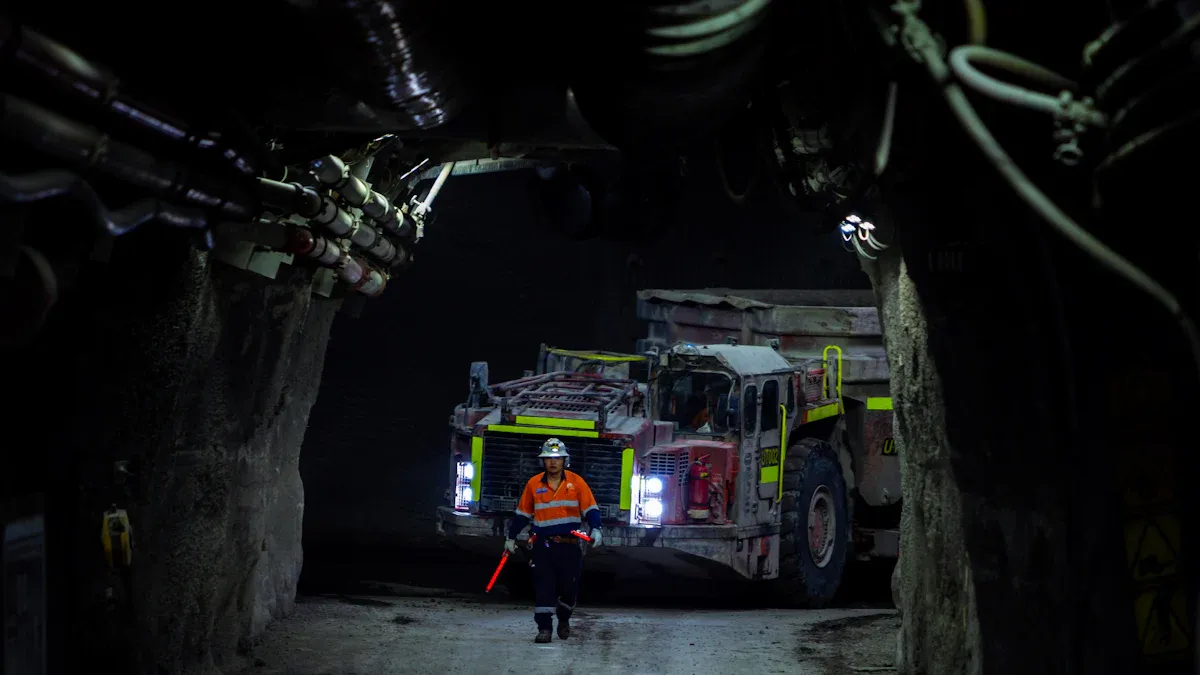Views: 0 Author: Site Editor Publish Time: 2025-09-09 Origin: Site










Underground loaders need to change fast for different mining jobs. This helps teams work better and keeps everyone safe.
Electric loaders make less pollution and cost less to run. They keep the air cleaner and need less fixing than diesel loaders.
Changing loaders for special jobs makes them work better. Things like articulated steering and quick attach systems help loaders do many jobs in small spaces.
Using smart ways to control power can save energy. Changing gearbox ratios and using battery management can help loaders work better.
Safety is very important in underground mining. Picking low-emission loaders and adding safety features keeps workers safe and follows the rules.

Underground loader power systems need to change fast in mines. Operators use different ways to control power and make work better. One way is to adjust the gearbox transmission ratio. This helps loaders use less energy each time they work. Engineers check how the motor uses power in different situations. They look for the best way for the loader to work. This makes the loader use less energy and carry the right amount. Studies show battery-powered loaders can use almost two percent less energy per cycle. If the battery stays in good shape, the loader can work more times. This helps the team get more done.
Mining teams want to do more work by using power better. Even a small increase in work can save a lot of money. Being efficient is not just about speed. It also means being safe, keeping machines working longer, and making more money. Mines often switch from diesel to battery-electric vehicles. This change uses less energy and needs less air for ventilation. No diesel fumes means the air is safer and healthier. Good electrification needs a strong battery plan. Teams set up charging spots based on work shifts and mine maps. They also watch for heat and fire because mines are closed spaces.
Tip: Teams should pick loader power systems that fit each mining job. This helps loaders carry more and work better.
Customization helps underground loaders work better in mines. Loader design often has features for tight spaces. Small frames and articulated steering help loaders reach hard spots. This makes it easier to move and carry more. Customization lets one loader do many jobs.
Customization Option | Description |
|---|---|
Forklift masts | Lets loaders lift and move things in small spaces, making work easier. |
Scissor lifts | Helps loaders reach up high in tight areas, saving time. |
Quick attach system | Lets teams change tools fast, so there is less waiting. |
Makes it easier to turn in small spaces, reaching places big machines cannot. |
Operators use mining attachments to make loaders work better. Quick attach systems help teams change tools quickly. This means less waiting and more work done. Forklift masts and scissor lifts help loaders move things and reach high places. Articulated steering helps loaders turn and move in small spaces.
Loader customization also adds better visibility and emergency stop features. These keep operators safe. Strong frames protect workers during hard jobs. Multi-purpose underground mining trucks use these options to carry different loads and tools. This makes them able to do more jobs and carry more.
How equipment is made changes how well loaders use power. Using electric power cuts down on fumes and saves energy. Automation helps loaders work faster and safer. Energy-saving designs help loaders do better in mines. Customization and mining attachments make loaders more useful and efficient. Teams can pick the right size and tools for each job. This helps them get more work done and be more efficient.
Tunneling needs strong underground mining equipment. Electric utility vehicles move well in tight tunnels. They help lower pollution in the mine. Electric shuttle cars carry heavy loads deep underground. These vehicles use energy better than fuel ones. They keep air clean and help save money.
Stoping and extraction need mining equipment that can change fast. Underground mining equipment must carry heavy loads in deep places. Electric loaders and trucks move ore and waste quickly. These machines use less energy and make work safer. New mining equipment uses automation to help teams work better and save money.

Underground mines have small tunnels and sharp corners. Loader operators find it hard to move equipment in these tight spaces. Small loader designs help teams work better. Special features like articulated steering and small frames help loaders turn easily. These features let loaders reach tough spots.
Small spaces make moving loaders hard.
Small designs and smart features help loaders work better.
Electric loaders do not make bad fumes. They help keep the air clean for workers. Teams spend less money on fuel and fixing. Electric loaders also make less noise.
Teams check the size of the mine. They look at the ground and how much needs lifting. They compare diesel, electric, and hybrid choices. Loader features and price are important too.
Tip: Teams should match loader power to each mining job. This helps loaders work better.
Yes, loaders with small frames can move in tight spaces. Articulated steering helps loaders turn easily. These designs help teams reach hard places.
Safety Feature | Benefit |
|---|---|
Emergency stop | Stops loader fast |
Better visibility | Helps operators see dangers |
Strong frames | Keeps workers safe from hits |